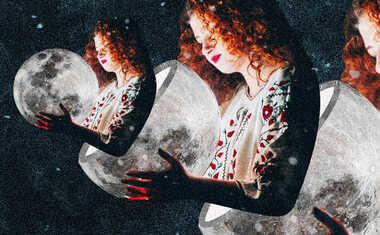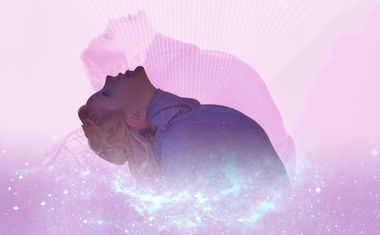
Iconology of the World Cards
From the Iconology Section of the Robert O'Neill Library
Introduction
Figure one shows the eight surviving World cards from the early Tarot. The modern viewer may be surprised to find that none of the oldest images correspond to the Tarot de Marseille card with a figure within a mandalora and four beasts.
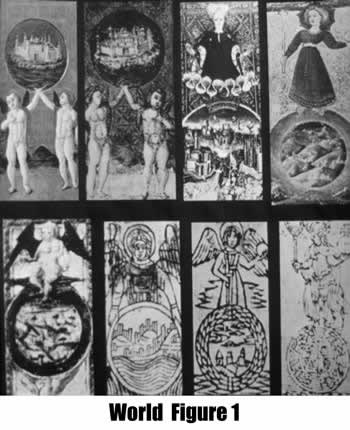 Instead the oldest cards show a city or scenery within the circle and the figure outside. In two cases, there is a pair of angels holding up the circle. In three cases the angel is atop the circle. In two cases, the angel is replaced by the figure of a woman. In the final case, the image of Mercury appears on top, and the scenery is replaced by what appears to be representations of the four elements. To the best of my knowledge, images such as those in Figure 1 do not appear in the general religious art of the period.
Instead the oldest cards show a city or scenery within the circle and the figure outside. In two cases, there is a pair of angels holding up the circle. In three cases the angel is atop the circle. In two cases, the angel is replaced by the figure of a woman. In the final case, the image of Mercury appears on top, and the scenery is replaced by what appears to be representations of the four elements. To the best of my knowledge, images such as those in Figure 1 do not appear in the general religious art of the period.
The early cards do seem to resemble two of the early 'Mantegna Tarocchi' images. Cosmico shows an angel holding up a circle containing the Cosmos. Apollo shows a crowned figure standing atop a circle containing the cosmos. Images of both cards can be seen at www.levity.com/alchemy/mantegna.html.
The triumphant tradition
The final poem of Petrarch's epic deals with the triumph of Eternity. There is no description or reference to a triumphal car or other specific imagery. Rather the poet says that the time is near when deeds will be judged and that if he is found worthy he may behold, "...the Highest Good."
The sparse visual hints given in Petrarch led to the final triumph of Eternity being represented in a number of different ways in the traditional imagery that developed from the poem. In some cases we find a representation of Christ seated on the triumphal car (Nyholm 1990, Fig. 11 ~1500). In other examples, we find God the Father holding up the Son Crucified (Eisenbichler and Iannucci 1990, p 348 Venice 1515).
A particularly elaborate example can be seen at www.adh.bton.ac.uk/schoolofdesign/MA.COURSE/LTPet06.html.
Here, the crucifixion scene is supported by angels with a pair blowing trumpets. The Sun and Moon appear in the sky. The car is pulled by four haloed men and the four beasts walk alongside the car. Although this image shows the same reliance on imagery from the Apocalyptic tradition that we have seen in other early Tarot cards, the central image bears little resemblance to the images in Fig. 1.
About the only representation of the Triumph of Eternity that seems to related to the early Tarot is seen in Figure 2. In this image from a 15th century engraving, the car is pulled by the four beasts and the seated Christ holds an orb like those seen in several of the early World cards. At his feet is a circle that appears to contain a landscape or city. This resembles the imagery in several of the cards of Fig. 1 that have a figure holding an orb atop the image of the World.
The apocalyptic tradition
The twenty-first card of the Tarot trumps seems to relate to the twenty-first chapter of Revelations:
21:1-2 "Then I saw a new heaven and a new earth...I saw the holy city, and the new Jerusalem, coming down from God out of heaven..." and again 21:9- "...showed me Jerusalem, the holy city, coming down from God out of heaven..."
 The representation of heaven as the New Jerusalem is an artistic tradition that dates back to mosaics in the oldest Christian churches. Kinney (1992) lists the following examples: St. Costanza, tower ~350, St. Pudenziana, apse 401/17, St. Lorenzo Maggiore, vestibule of the Chapel of S. Aquilino, ~ 4th century. Klein (1992) adds an example from St. Prassede in Rome (817-824).
The representation of heaven as the New Jerusalem is an artistic tradition that dates back to mosaics in the oldest Christian churches. Kinney (1992) lists the following examples: St. Costanza, tower ~350, St. Pudenziana, apse 401/17, St. Lorenzo Maggiore, vestibule of the Chapel of S. Aquilino, ~ 4th century. Klein (1992) adds an example from St. Prassede in Rome (817-824).
Figure 3 shows an a manuscript illustration of Revelations from the 12th century in which the child Jesus is being saved from the Dragon by being drawn up into heaven, shown as the New Jerusalem within a circle. Another example of the New Jerusalem from a 12th century altarpiece is shown in Figure 4. A Flemish manuscript ~1400 illustrates Revelations Chapter 21 with an image of John being shown the New Jerusalem as the heavenly city (van der Meer 1978, Fig. 155). A similar image from a 14th century tapestry is shown in Figure 5. Interestingly, an almost identical image is found in the 15th century Visconti Psalter, but represents Moses being shown the Promised Land (Meiss 1972, LF128). Another image from the same source is shown in Figure 6. The image shows God the Father holding up a circle representing the World. Fig. 6 resembles the early Tarot image except that the substitution of God the Father for an angel or allegorical figure would have been considered very significant at the time.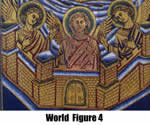
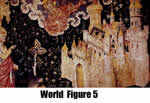 Representations of the world within a circle were not uncommon in the 15th century. Examples, such as Fig. 7, can be found in many illuminated manuscripts. However, in many cases including Figure 7 the image is not specifically referenced to Revelations and we cannot infer that the image in the circle specifically refers to the New Jerusalem.
Representations of the world within a circle were not uncommon in the 15th century. Examples, such as Fig. 7, can be found in many illuminated manuscripts. However, in many cases including Figure 7 the image is not specifically referenced to Revelations and we cannot infer that the image in the circle specifically refers to the New Jerusalem.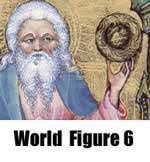
Iconological analysis
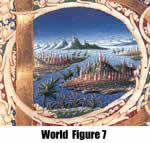 Images resembling the early Tarot cards can certainly be found in 14-16th century paintings. In the cases containing angels, one can argue that these cards are representations of the New Jerusalem and would have been recognized as such. However, similar images appear in other contexts as simply representations of the world or cosmos without any specific reference to Revelations. It is certainly true that the most common illustrations of Revelations Chapter 21 show John, the Angel and a full page illustration of a city.
Images resembling the early Tarot cards can certainly be found in 14-16th century paintings. In the cases containing angels, one can argue that these cards are representations of the New Jerusalem and would have been recognized as such. However, similar images appear in other contexts as simply representations of the world or cosmos without any specific reference to Revelations. It is certainly true that the most common illustrations of Revelations Chapter 21 show John, the Angel and a full page illustration of a city.
Although it is beyond the scope of the present study, we would be remiss if we did not make reference to the familiar World image of the Tarot de Marseilles that shows a figure in mandalora with 4 beasts. This image is based on Revelations 4 "... and I saw a throne standing in heaven and the One who was sitting on the throne...There was a rainbow encircling the throne...grouped around the thone itself, were four animals...The first animal was like a lion, the second like a bull, the third animal had a human face and the fourth animal was like a flying eagle..."
This visual image, which harkens back to Ezechial 1 and 10 and Isaiah 6, would have been familiar to any early Renaissance card-player. The theme goes back at least to the 4th century as evidenced by the mosaic at St. Prudenziana in Rome (Klein 1992). The theme is also shown as throne and cross in rainbow wreath, surrounded by the four beasts in a mosaic (431-440) from St. Maria Maggiore in Rome (van der Meer 1978, figure 12). The same source (Figure 36) shows a 6th century fresco with the same theme from the Nile valley. After the 9th century, the familiar themes of the mandalora and the four beasts at the corners have become established.
The impeccable scholarship of van der Meer (1978) provides illustrations from a Carolingen illustrated Apocalypse ~500 (Fig. 57) , a bible illustration from Tours 840 (Fig. 44), a Rhineland illustration ~827 (Fig. 45), an illustration from St. Denis Abbey 869 (Fig. 46), a 10th century Rhineland mosaic (Fig. 33), an 11th century illustration (Fig. 78), an illustration from 1120 (Fig. 87), bas relief from a portal of Notre Dame 1144-1155 (Fig. 41), an Italian Abbey church ~1350 (Fig. 136), a fresco in Padua 1378 (Fig. 128), a Flemish manuscript ~1400 (Figs. 141, 142, 144), a Dutch woodcut 1420-1435 (Fig. 176), a painted wooden panel 1460 (Fig. 43) and a 1480 tapestry Fig. 120).
Grubb (1997) provides illustrations from an early (~950) commentary on Revelations (p. 15), from a 12th century Westminster Psalter (p. 140), from Venice 1397 (p. 16) and Santa Maria Novella from the late 14th century (p. 130) , and from and early 15th century Psalter (p. 140). Deutcher (1971) provides an example from an early 14th century illustrated Apocalypse (p. 39). James (1931) lists a number of additional examples but provides no images.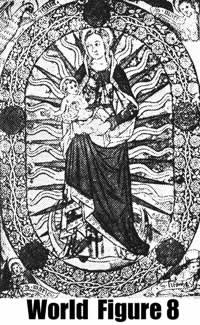
Although almost all of these images have a male figure in the center of the mandalora, there are exceptions. Figure 8 shows a 15th century woodcut in which the Woman from Revelations is shown within the mandalora. Figure 9 shows a 14th century Florentine bas relief with the Virgin within the mandalora. Figure 10 shows a second example by Nanni di Banco from the Duomo in Florence (1414-1421).
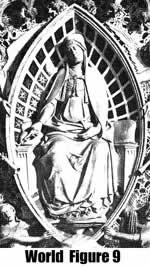 Perhaps the most intriquing image is a 16th century illustration in an alchemical text illustrating the "Anima Mundi" (Figure 11). This image shows a naked female figure within a mandalora formed by wings. The image seems to be related to the Tarot de Marseilles card and the title of "Anima Mundi", i.e., "Spirit of the World" would seem to relate to the title of the early Tarot card.
Perhaps the most intriquing image is a 16th century illustration in an alchemical text illustrating the "Anima Mundi" (Figure 11). This image shows a naked female figure within a mandalora formed by wings. The image seems to be related to the Tarot de Marseilles card and the title of "Anima Mundi", i.e., "Spirit of the World" would seem to relate to the title of the early Tarot card.
In a real sense, the Tarot de Marseille image of the World card in general and Figure 11 in particular pose a dilemma that can only be resolved by future research. The extant 15/16th century World cards (numbered 21) show an image that seems to be related to Revelations chapter 21, the New Jerusalem. That image seems consistent with an interpretation of the tarot trumps as the Fool's Journey, culminating in the final Resurrection of the Body (19), Final Judgment (20), and the final reward of heaven, represented by the New Jerusalem (21).
On the other hand, the Tarot de Marseille image of the mandalora and four beasts would also have been familiar to the 15th century card-player. That image forms the apex of a number of publically accessible frescoes of the Last Judgment. There is reason to argue that the 15th century viewer would have recognized the Tarot de Marseille imagery as the culmination of the anticipated escatology. This idea is reinforced by an image (1337/9) in the public palace in Sienna (Edgerton 1985, p.36). A female image, representing Wisdom, hovers directly above the enthroned Justice. If the Tarot de Marseille image is meant to represent Wisdom, then the gender of the image is explained, as well as its position immediately above Justice in the type B ordering of the trumps.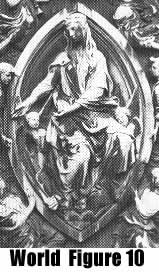
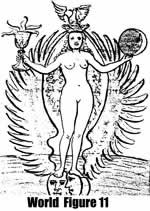 The only hypothesis that I can offer is the following. The original designers followed Revelations and designed the 21st card to represent the New Jerusalem presented in the corresponding 21st chapter of Revelations. After the deck entered France, the designers were astute enough to recognize that the Mandalora/Beast image might be more recognizable by the card-players and made the substitution.
The only hypothesis that I can offer is the following. The original designers followed Revelations and designed the 21st card to represent the New Jerusalem presented in the corresponding 21st chapter of Revelations. After the deck entered France, the designers were astute enough to recognize that the Mandalora/Beast image might be more recognizable by the card-players and made the substitution.
Interpretation
In all likelihood, the 15th century card-player would have seen the World card (Fig. 1) as representing the culmination of the earthly journey, represented in Revelations as the New Jerusalem. Although the cardplayer was not inundated with similar imagery, neverthless, the concept would have been familiar from sermons. The theme of the journey to the New Jerusalem also appears in the poetry and literature of late 14th century (Nolan 1977). The familiar epic poems of Dante and Petrarch both conclude in Paradise with the Beatific vision.
Perhaps the strongest argument that this card would have been seen as the New Jerusalem is its position in the Trumps. The World card is the 21st trump and the New Jerusalem appears in the 21st chapter of Revelations. The card-player probably had not read the New Testament in Latin, although literacy was more common in the Renaissance than is commonly thought (Grendler 1989).
It is possible that the imagery of the early cards could have been interpreted as the natural world, i.e., earth. However, in the Neoplatonic cosmology and hierarchical society of the early Renaissance, it is unlikely that the viewer would have considered the natural world as 'higher' than the star-moon-sun cards. It is also hard to avoid the conclusions that the New Jerusalem would have been seen as the logical next step following the Resurrection of the Body (Angel card) and the Final Judgment (Justice card).

